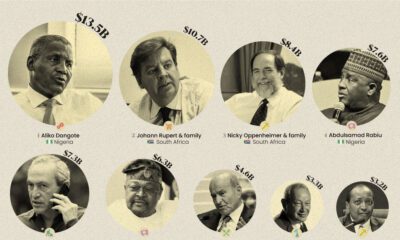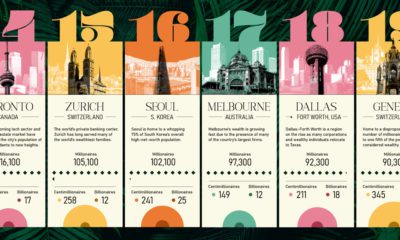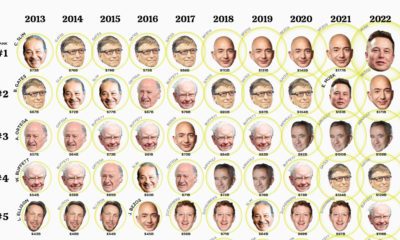For example, a heavy-hitting millionaire might have the most impressive fortune in his or her home state — but venture a few miles across the state border, and suddenly they become a small fish in a much bigger pond. Today’s map comes to us from HowMuch.net, and it shows the incredible variance in the biggest fortunes on a state-by-state basis.
The Rich List, by State
Below is the full list containing the wealthiest person in every U.S. state, based on calculations by Forbes in early March 2020. While all of the names above are considered extraordinarily wealthy in their home states, there is still a magnitude of difference involved. The low end of the list ($0.3 billion) would need to multiply their fortune by 390 times to get up to the $117.1 billion Bezos level. To put this another way, the same degree of difference exists between the median household wealth in the U.S. (~$100,000) and a multi-millionaire with $39 million to their name.
Rising and Falling Fortunes
The above figures were obtained prior to the COVID-19 market crash, which will surely impact the size of some of the fortunes listed here. Who will be most and least impacted by the recent stock market turmoil? Warren Buffett is also an interesting case. Though the stock market has certainly disrupted the real-time value of his fortune, that’s not the game that Warren Buffett plays. In fact, he is known for waiting for times of crisis to deploy his cash, and has a significant stockpile of money ready for just this kind of situation. Billionaires like Sheldon Adelson in Nevada or Philip Anschutz of Colorado might be singing a different tune than some of the other above magnates. Adelson, for example, owns a good chunk of the Las Vegas Strip, as well as casinos and hotels in Singapore and Macao. Unfortunately, tourism-related businesses are some of the hardest hit in the COVID-19 crash. Meanwhile, Anschutz owns the Coachella Music Festival and stakes in many professional sports teams (LA Lakers, LA Kings, and multiple MLS teams), which have all been impacted by the cancellation of big events and gatherings throughout the country. Like many others, Anschutz is probably itching for things to get back to normal. on Both figures surpassed analyst expectations by a wide margin, and in January, the unemployment rate hit a 53-year low of 3.4%. With the recent release of February’s numbers, unemployment is now reported at a slightly higher 3.6%. A low unemployment rate is a classic sign of a strong economy. However, as this visualization shows, unemployment often reaches a cyclical low point right before a recession materializes.
Reasons for the Trend
In an interview regarding the January jobs data, U.S. Treasury Secretary Janet Yellen made a bold statement: While there’s nothing wrong with this assessment, the trend we’ve highlighted suggests that Yellen may need to backtrack in the near future. So why do recessions tend to begin after unemployment bottoms out?
The Economic Cycle
The economic cycle refers to the economy’s natural tendency to fluctuate between periods of growth and recession. This can be thought of similarly to the four seasons in a year. An economy expands (spring), reaches a peak (summer), begins to contract (fall), then hits a trough (winter). With this in mind, it’s reasonable to assume that a cyclical low in the unemployment rate (peak employment) is simply a sign that the economy has reached a high point.
Monetary Policy
During periods of low unemployment, employers may have a harder time finding workers. This forces them to offer higher wages, which can contribute to inflation. For context, consider the labor shortage that emerged following the COVID-19 pandemic. We can see that U.S. wage growth (represented by a three-month moving average) has climbed substantially, and has held above 6% since March 2022. The Federal Reserve, whose mandate is to ensure price stability, will take measures to prevent inflation from climbing too far. In practice, this involves raising interest rates, which makes borrowing more expensive and dampens economic activity. Companies are less likely to expand, reducing investment and cutting jobs. Consumers, on the other hand, reduce the amount of large purchases they make. Because of these reactions, some believe that aggressive rate hikes by the Fed can either cause a recession, or make them worse. This is supported by recent research, which found that since 1950, central banks have been unable to slow inflation without a recession occurring shortly after.
Politicians Clash With Economists
The Fed has raised interest rates at an unprecedented pace since March 2022 to combat high inflation. More recently, Fed Chairman Jerome Powell warned that interest rates could be raised even higher than originally expected if inflation continues above target. Senator Elizabeth Warren expressed concern that this would cost Americans their jobs, and ultimately, cause a recession. Powell remains committed to bringing down inflation, but with the recent failures of Silicon Valley Bank and Signature Bank, some analysts believe there could be a pause coming in interest rate hikes. Editor’s note: just after publication of this article, it was confirmed that U.S. interest rates were hiked by 25 basis points (bps) by the Federal Reserve.












